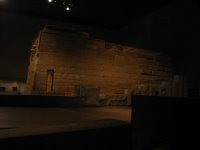Ancient Egypt
Of all the civilizations of antiquity, the Egyptian seems to me to have been the most pleasant.- Otto Neugebauer

 When I think of ancient civilizations and astronomy, Babylonians, Greeks, and Arabs immediately come to mind. Almost instinctively I want to group the Egyptians since they too represent a prominent civilization of antiquity. However, Egyptians don't figure much in the history of astronomy, yet they figure a lot in our exit from the Top of the Lawn.
When I think of ancient civilizations and astronomy, Babylonians, Greeks, and Arabs immediately come to mind. Almost instinctively I want to group the Egyptians since they too represent a prominent civilization of antiquity. However, Egyptians don't figure much in the history of astronomy, yet they figure a lot in our exit from the Top of the Lawn.At the completion of most observing sessions at TotL, we exit the park to the east, passing The Metropolitan Museum of Art (The Met). A glass wall spans nearly the enitre depth of the building and rises more than 60 feet to display the Met's Egyptian collection. I don't give it much notice other than silent acknowledgement that it is big and impressive. The lawn between the sidewalk and glass wall has always been a disciplinary boundary which kept me back.
A recent evening when we left, a couple of clusters of kids were seen sitting on the lawn beside the museum. I was surprised because I didn't think anyone was allowed there, especially so close to the museum. One group of three had lit a candle and they were singing as one of them strummed a guitar. Nearby another couple sat and chat while over their heads I could see through the window a museum guard sitting in a chair. Another group of kids ran right up to the window and walked the building's length in toward the park. Charlie gestured with arm, "Come on." And off we went up to look at the treasures.
Looking through the window the Temple of Dendur anchors the west part of this huge room. In the foreeground just in the other side of the pane of glass is a sarcophagus. Further down the room to the east statues stand against the wall. Pretty impressive that these structures and works of art are the handicraft of men 2000 years ago!
 This is a picture of the gate of the Temple of Dendur. Made of sandstone, it comes from ancient Nubia some time around 15 B.C. Its total length from gate to rear of temple is 82 ft. The temple, with its gate facing the Nile, was built into a hillside in Upper Nubia where the river valley is very narrow. Originally the gate was set in a high wall of mud bricks that surrounded the temple, but gradually recurrent high water destroyed the wall.
This is a picture of the gate of the Temple of Dendur. Made of sandstone, it comes from ancient Nubia some time around 15 B.C. Its total length from gate to rear of temple is 82 ft. The temple, with its gate facing the Nile, was built into a hillside in Upper Nubia where the river valley is very narrow. Originally the gate was set in a high wall of mud bricks that surrounded the temple, but gradually recurrent high water destroyed the wall.The gate figures prominently here with the temple in the background at the lower right of the photograph. Atop of the gate the lintel is reconstructed with another material to depict its original structure.
(A map of ancient Nubia? or Nubia at Wikipedia)
 One can see the entire structure and more detailed information by navigating to page 4 at the Met's Art of Ancient Egypt site.
One can see the entire structure and more detailed information by navigating to page 4 at the Met's Art of Ancient Egypt site.Similar to reconstruction of the Gate, one can distingush in this photo the stones that are used for replacement elements.
Quotation cited
Neugebauer, Otto. The Exact Sciences in Antiquity. Dover Publications
<< Home